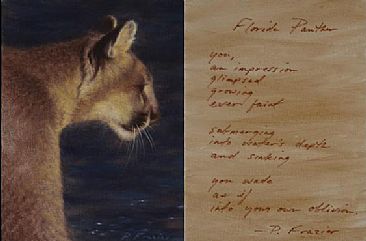 |

    
Members
Login
|
 Phyllis Frazier
AFC Phyllis Frazier
AFC

Wildlife, Endangered Species, and Conservation |
|

|
|
| |

| 2011 - AFC Blog Post: Painting, Poetry, and the Heart of Conservation - Part 1 |
 |
 A dear friend recently asked me the question, "Why do you paint animals?" Although we drifted on to other topics before a response could be articulated, I think of this question, often, as I create my artwork.
A dear friend recently asked me the question, "Why do you paint animals?" Although we drifted on to other topics before a response could be articulated, I think of this question, often, as I create my artwork.
A litany of responses emerge: because I love them...because I love looking at them.... I love learning about them, studying them, thinking about their lives and behaviors, marveling at their forms and how perfectly tailored to their worlds that their bodies and movements have evolved to suit them.... These reasons seem endless to me as I contemplate all that I find beautiful and inspiring about them, and the natural worlds they inhabit.
Other reasons emerge for me, as well - because I can't stop thinking about the fact that they, and their worlds, are so rapidly disappearing.
But mostly, I paint animals because my heart feels aligned with them, as fellow beings more perfect than myself, whose very existence and anciently established habits ensure the quality and functioning of nature itself - a connection that saddens me as I imagine their presence no more.
I feel a profound spiritual emptiness as I contemplate their future relegated to taxidermied specimens, video footage and photographs, and also, I humbly acknowledge, to art itself.
Back to my reasons for painting them...
At the core of art-making, is the desire and attempt to "capture" the ephemeral. To immortalize it, to share it (the best we can), to celebrate it, that we were alive and graced with the chance to witness it and let it enter our psyche and soul.
I think what we, specifically as wildlife and nature artists, are trying to achieve through our work is to bring the viewer into our reverie, into our awe and astonishment of that which we find so magnificent, that which touches us as we see it in the natural world. As such, I feel that the viewer of our work "bears witness" to our experience of nature, entering a shared internal space with us.
But somehow, I am often left feeling that there is a missing component.
I found I was seeking a more direct connection in the invisible dialog between art and the observer - some method of connecting that could reach beyond the visual, beyond the intellect, and enter the heart.
That "something" that came to mind for me, for my own work, was my poetry - an alignment of the feelings about what I am seeing and experiencing with a more direct, emotive, and potent form of communication. I wanted a greater understanding of the feelings behind my work... to bring those feelings up to the fore, make them visible and accessible to the viewer.
More and more, as I began an artwork, I found myself writing out my emotional impressions of why I was painting or drawing the subject - what touched me, where that brought my heart, and what I hoped to communicate by the visual... the finished art piece.
I wanted to bring the heart into the matter.
Then, one day, it hit me - the idea emerged to bring those poems to light and share them alongside my visual artworks, to elevate the poems to a form of art piece in their own right. Influenced by some element within the primary work to further its message, the poem began to take on an equal visual presence, resulting in a form of diptych of art and poem.
It isn't enough, I feel, that people understand intellectually, quantitatively, what is happening to the natural world - the losses of species we are experiencing. What is needed, is a connecting to what that loss means to us on a deeper level, at a felt sense, to our hearts.
In choosing to align my own art with my poetry, and share my heart energy, it is in the hope that doing so will awaken the same deep connection within those who view it, and inspire the taking of heart-based action toward protecting our natural world.
I feel strongly, that the art/poetry duet is a powerful vehicle to accomplish this.
It has been said, "The pen is mightier than the sword." The artist/poet, Kenneth Patchen, once remarked, "the [paint] brush is merely an extension of writing."
So perhaps, the combination of paintbrush and pen will produce a doubly-potent form of environmental activism and inspiration, grounded in the best of the human spirit itself.
The implications of this, I feel, are exciting, indeed.
In Part 2 of this series, I will explore some history of artists using poetry with their artwork, as well as discuss significant projects where this combination has been successfully utilized to further awareness of environmental issues.
See the original AFC Post here: http://www.artistsforconservation.org/blog-entry/afc/painting-poetry-and-heart-conservation |
|
|
|
| |
 |
|
|
 |
 |
|

|
|